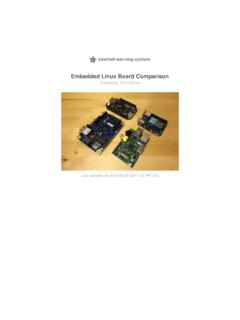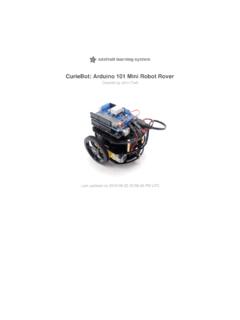Transcription of All About Stepper Motors - Adafruit Industries
1 All About Stepper MotorsCreated by Bill EarlLast updated on 2020-02-17 12:18:50 PM UTCWhat is a Stepper motor ? Stepper Motors are DC Motors that move in discrete steps. They have multiple coils that are organized in groupscalled "phases". By energizing each phase in sequence, the motor will rotate, one step at a a computer controlled stepping you can achieve very precise positioning and/or speed control. For this reason, Stepper Motors are the motor of choice for many precision motion control applications. Stepper Motors come in many different sizes and styles and electrical characteristics. This guide details what you needto know to pick the right motor for the job.
2 Adafruit 3 of 29 A 4-phase unipolar from Wikimedia CommonsWhat are Stepper Motors good for?Positioning Since steppers move in precise repeatable steps, they excel in applications requiring precisepositioning such as 3D printers, CNC, Camera platforms and X,Y Plotters. Some disk drives also use steppermotors to position the read/write Control Precise increments of movement also allow for excellent control of rotational speed for processautomation and Speed Torque - Normal DC Motors don't have very much torque at low speeds. A Stepper motor hasmaximum torque at low speeds, so they are a good choice for applications requiring low speed with highprecision.
3 Adafruit 4 of 29 What are their limitations?Low Efficiency Unlike DC Motors , Stepper motor current consumption is independent of load. They draw themost current when they are doing no work at all. Because of this, they tend to run High Speed Torque - In general, Stepper Motors have less torque at high speeds than at low steppers are optimized for better high-speed performance, but they need to be paired with an appropriatedriver to achieve that Feedback Unlike servo Motors , most steppers do not have integral feedback for position. Although greatprecision can be achieved running open loop.
4 Limit switches or home detectors are typically required for safetyand/or to establish a reference position. Adafruit 5 of 29 Adafruit 6 of 29 Types of SteppersThere are a wide variety of Stepper types, some of which require very specialized drivers. For our purposes, we willfocus on Stepper Motors that can be driven with commonly available drivers. These are: Permanent Magnet or Hybridsteppers, either 2-phase bipolar, or 4-phase SizeOne of the first things to consider is the work that the motor has to do. As you might expect, larger Motors are capableof delivering more power. Stepper Motors come in sizes ranging from smaller than a peanut to big NEMA 57 monsters.
5 Most Motors have torque ratings. This is what you need to look at to decide if the motor has the strength to do whatyou 17 is a common size used in 3D printers and smaller CNC mills. Smaller Motors find applications in many roboticand animatronic applications. The larger NEMA frames are common in CNC machines and industrial NEMA numbers define standard faceplate dimensions for mounting the motor . They do not define the othercharacteristics of a motor . Two different NEMA 17 Motors may have entirely different electrical or mechanicalspecifications and are not necessarily interchangeable. Adafruit 7 of 29 Step CountThe next thing to consider is the positioning resolution you require.
6 The number of steps per revolution ranges from 4to 400. Commonly available step counts are 24, 48 and is often expressed as degrees per step. A motor is the same as a 200 step/revolution trade-off for high resolution is speed and torque. High step count Motors top-out at lower RPMs than similar the higher step-rates needed to turn these Motors results in lower torque than a similar size low-step-count motorat similar way to achieve high positioning resolution is with gearing. A 32:1 gear-train applied to the output of an 8-steps/revolution motor will result in a 256 step gear train will also increase the torque of the motor .
7 Some tiny geared steppers are capable of impressive the tradeoff of course is speed. Geared Stepper Motors are generally limited to low RPM is another issue with geared Motors . When the motor reverses direction, it needs to take up any slack theremay be in the gear-train. This can affect positioning accuracy. Adafruit 8 of 29 Shaft StyleAnother thing to consider is how the motor will interface with the rest of the drive system. Motors are available with anumber of shaft styles:Round or "D" Shaft: These are available in a variety of standard diameters and there are many pulleys, gears andshaft couplers designed to fit.
8 "D" shafts have one flattened side to help prevent slippage. These are desirablewhen high torques are shaft: Some shafts have gear teeth milled right into them. These are typically designed to mate withmodular gear Shaft: Motors with lead-screw shafts are used to build linear actuators. Miniature versions of thesecan be found as head positioners in many disk drives. Adafruit 9 of 29 WiringThere are many variations in Stepper motor wiring. For our purposes, we will focus on steppers that can be driven withcommonly available drivers. These are Permanent Magnet or Hybrid steppers wired as 2-phase bipolar, or 4-phaseunipolar.
9 Adafruit 10 of 29 Coils and PhasesA Stepper motor may have any number of coils. But these are connected in groups called "phases". All the coils in aphase are energized vs. BipolarUnipolar drivers, always energize the phases in the same way. One lead, the "common" lead, will always be other lead will always be positive. Unipolar drivers can be implemented with simple transistor circuitry. Thedisadvantage is that there is less available torque because only half of the coils can be energized at a drivers use H-bridge circuitry to actually reverse the current flow through the phases. By energizing the phaseswith alternating the polarity, all the coils can be put to work turning the two phase bipolar motor has 2 groups of coils.
10 A 4 phase unipolar motor has 4. A 2-phase bipolar motor will have 4wires - 2 for each phase. Some Motors come with flexible wiring that allows you to run the motor as either bipolar orunipolar. Adafruit 11 of 295-Wire MotorThis style is common in smaller unipolar Motors . All ofthe common coil wires are tied together internally andbrought out as a 5th wire. This motor can only be drivenas a unipolar MotorThis motor only joins the common wires of 2 pairedphases. These two wires can be joined to create a 5-wire unipolar motor . Or you just can ignore them and treat it like a bipolarmotor!8-Wire MotorThe 8-wire unipolar is the most versatile motor of all.









